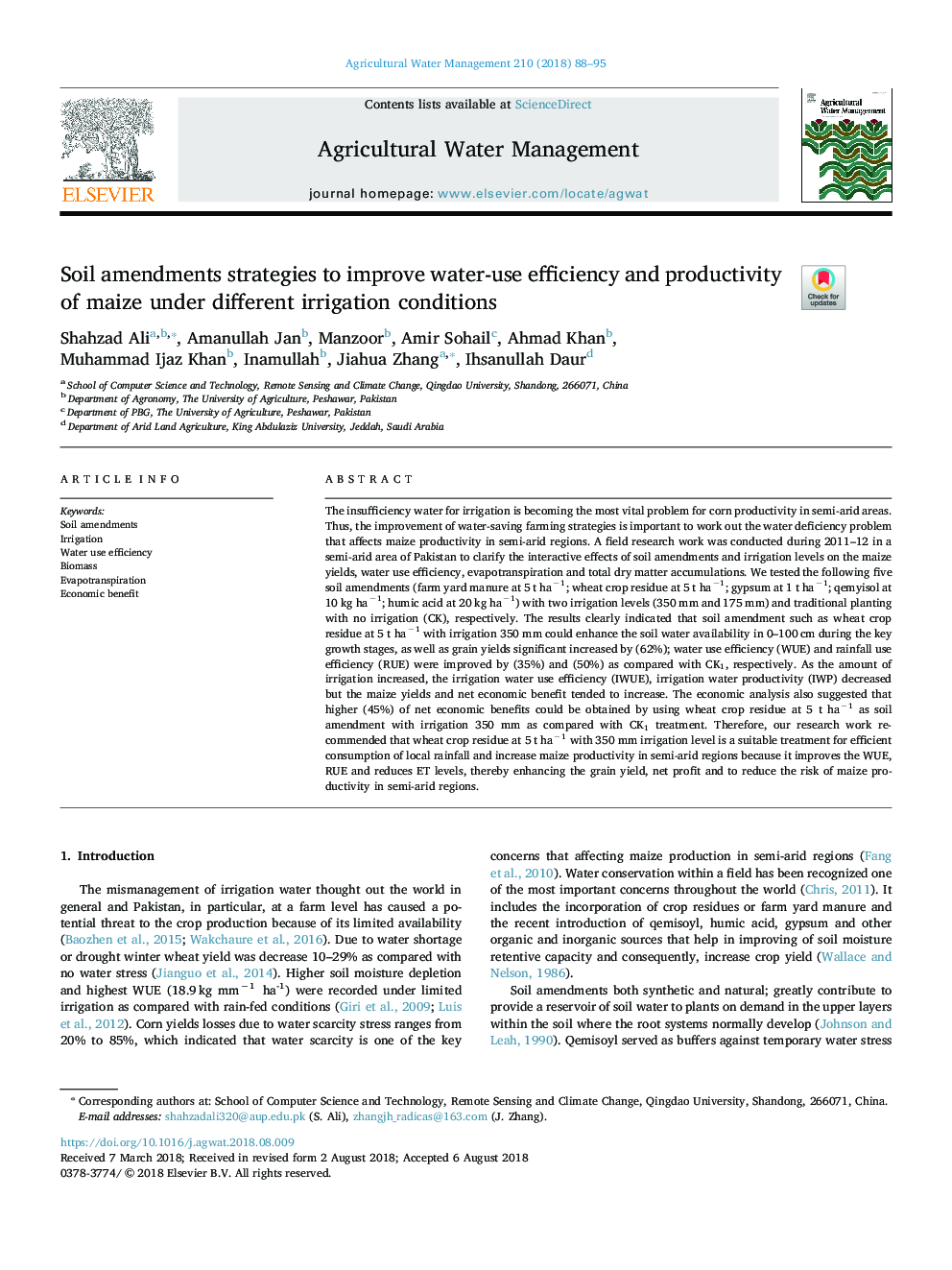| کد مقاله | کد نشریه | سال انتشار | مقاله انگلیسی | نسخه تمام متن |
|---|---|---|---|---|
| 8872706 | 1622870 | 2018 | 8 صفحه PDF | دانلود رایگان |
عنوان انگلیسی مقاله ISI
Soil amendments strategies to improve water-use efficiency and productivity of maize under different irrigation conditions
ترجمه فارسی عنوان
استراتژی های اصلاحی خاک برای بهبود بهره وری استفاده از آب و بهره وری ذرت تحت شرایط آب و هوایی مختلف
دانلود مقاله + سفارش ترجمه
دانلود مقاله ISI انگلیسی
رایگان برای ایرانیان
کلمات کلیدی
اصلاحات خاک، آبیاری، بهره وری استفاده از آب، زیست توده، تبخیر تعرق، مزایای اقتصادی،
موضوعات مرتبط
علوم زیستی و بیوفناوری
علوم کشاورزی و بیولوژیک
علوم زراعت و اصلاح نباتات
چکیده انگلیسی
The insufficiency water for irrigation is becoming the most vital problem for corn productivity in semi-arid areas. Thus, the improvement of water-saving farming strategies is important to work out the water deficiency problem that affects maize productivity in semi-arid regions. A field research work was conducted during 2011-12 in a semi-arid area of Pakistan to clarify the interactive effects of soil amendments and irrigation levels on the maize yields, water use efficiency, evapotranspiration and total dry matter accumulations. We tested the following five soil amendments (farm yard manure at 5 t haâ1; wheat crop residue at 5 t haâ1; gypsum at 1 t haâ1; qemyisol at 10 kg haâ1; humic acid at 20 kg haâ1) with two irrigation levels (350 mm and 175 mm) and traditional planting with no irrigation (CK), respectively. The results clearly indicated that soil amendment such as wheat crop residue at 5 t haâ1 with irrigation 350 mm could enhance the soil water availability in 0-100â¯cm during the key growth stages, as well as grain yields significant increased by (62%); water use efficiency (WUE) and rainfall use efficiency (RUE) were improved by (35%) and (50%) as compared with CK1, respectively. As the amount of irrigation increased, the irrigation water use efficiency (IWUE), irrigation water productivity (IWP) decreased but the maize yields and net economic benefit tended to increase. The economic analysis also suggested that higher (45%) of net economic benefits could be obtained by using wheat crop residue at 5 t haâ1 as soil amendment with irrigation 350 mm as compared with CK1 treatment. Therefore, our research work recommended that wheat crop residue at 5 t haâ1 with 350 mm irrigation level is a suitable treatment for efficient consumption of local rainfall and increase maize productivity in semi-arid regions because it improves the WUE, RUE and reduces ET levels, thereby enhancing the grain yield, net profit and to reduce the risk of maize productivity in semi-arid regions.
ناشر
Database: Elsevier - ScienceDirect (ساینس دایرکت)
Journal: Agricultural Water Management - Volume 210, 30 November 2018, Pages 88-95
Journal: Agricultural Water Management - Volume 210, 30 November 2018, Pages 88-95
نویسندگان
Shahzad Ali, Amanullah Jan, Manzoor Manzoor, Amir Sohail, Ahmad Khan, Muhammad Ijaz Khan, Inamullah Inamullah, Jiahua Zhang, Ihsanullah Daur,
